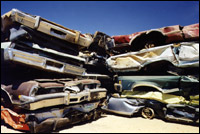Dear Umbra,
My wife and I are making plans to purchase our first hybrid vehicle and need to properly dispose of our current car — a 1989 Buick LeSabre. My question is, what is the best way to get rid of it? It is old and has a lot of miles on it. I suppose the dealer may take it off our hands for a very small trade-in amount — at which point, they will probably just send it to the scrap yard. What are the odds of it getting properly recycled at that point? Should I first see if I can donate it to some charity? What actually happens to a car at the end of its life?
Bryan Walton
Madison, Wis.
Dearest Bryan,
Have I pointed you to the Union of Concerned Scientists’ Hybrid Center yet? Might help in your choose-your-own-hybrid adventures.

The end of the road.
The LeSabre has served you well, and you are right to respectfully consider its next life. Charitable organizations get money from cars the same way you can: selling them at auction, privately, or for scrap. If you need the cash in hand, either the trade-in or selling to a needy teenager will be the best choice, but a donation deduction might have higher worth. Get the dealer’s offer, scope out the classifieds of your choice to see if you can get any cash locally, and ask your friendly neighborhood accountant what you’ll be able to deduct if you donate (the rules changed for 2005).
If your car ends up getting junked, it should be considered a desirable source of reusable materials. (This rundown of each state’s auto-recycling regulations will give you a hint of the details that salvage yards must master.) Your trusty steed will be gutted, with fluids drained and useful organs such as alternators, tires, transmission, and seats removed for resale. Next, crushing! Your giant car becomes a dense cube. The cube is then shredded, and shreds are sorted into three separate categories: ferrous, non-ferrous, and waste material. (If you please, observe an animated diagram of the process as it occurs at highly efficient plants in Europe.)
The EPA says 10.5 million cars “reach the end of their useful lives” in the U.S. each year. It estimates that 75 percent of each car’s weight is recycled, which is impressive. But it’s that other 25 percent that’s the trouble. Despite this residue’s fun name — auto fluff! — it is the main downside to your reprocessed vehicle. It has no easy use, can contain toxins such as mercury and lead, and usually ends up in a landfill. Check out the Clean Car Campaign to learn more about putting the brakes on use of these nasties in the car-manufacturing process.
For inspiration we look again to Europe, which has induced vehicle manufacturers to assume end-of-life responsibility for their products. This “market intervention” is spurring innovation on both the manufacturing and disposal ends. In the U.S., of course, such market intervention is still considered bad for business. Sigh.
But to wrap up: You have given your vehicle a full life. You have good choices in front of you, some involving remuneration. And you are buying a hybrid. Hoorah!
Fluffily,
Umbra

